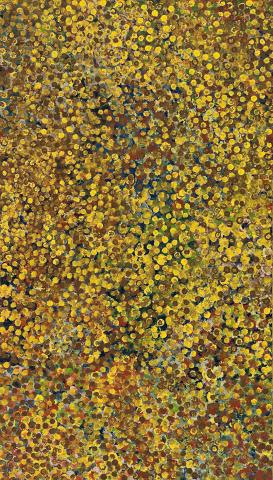THE FIRST FLOWERS OF SUMMER, 1990
EMILY KAME KNGWARREYE
synthetic polymer paint on canvas
210.0 x 122.0 cm
bears inscription verso: Artist's name and Delmore gallery cat. 0Q64
Commissioned by Delmore Gallery, via Alice Springs
Holt collection, Delmore Station via Alice Springs
Private collection, Melbourne
Isaacs, J., Smith, T., Ryan, J., Holt, D., and Holt, J., Emily Kame Kngwarreye Paintings, Craftsman House, Sydney, 1998, pl. 14, p. 60 (illus.)
The genius of Emily Kame Kngwarreye is evident in the way she created highly evocative paintings of great visual complexity out of deceptively simple marks with the brush. The First Flowers of Summer, 1990 is painted with an intense chromatic palette in closely matched, high key tones where the overlapping brush marks create an optical density that, apart from a few areas in the background where the colour is muted by white or black, does not allow the eye to rest or pause but to continually swirl across the canvas. It is as if the canvas is not allowed to breath. The effect is to evoke the dizzying, suffocating summer heat of December in the desert. Yellow and brown ochre dots float in and out over a field of red, green and blue. Each feathered brush mark suggests the myriad of plants that bloom at this time of year. As the seasons turn, the land is again a teeming resource of foods, medicines, of raw materials from which weapons and tools will be fashioned and ceremonial decorations made.
Emily Kame Kngwarreye painted a number of canvases in this style, including Drying wildflowers in summertime of 1991 in the collection of the Art Gallery of Western Australia.1 In 1993 she reprised the style in a series of panel paintings, including one in the collection of the Newcastle Regional Art Gallery.2 These paintings glow with a sense of exuberant celebration of the ancestral forces that permeate the earth.
1. see Carrigan, B. (ed.), Utopia: Ancient Cultures, New Forms, Heytesbury and Art Gallery of Western Australia, Perth, 1998, p. 45 (illus.)
2. see Neale, M. et al., Emily Kame Kngwarreye. Utopia: The genius of Emily Kame Kngwarreye, The National Museum of Art, Osaka, 2008, pl. D-29 to D-33 (illus.)
WALLY CARUANA
